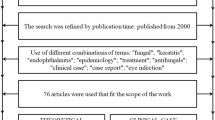Abstract
Purpose of Review
We sought to explore the current incidence and associated risk factors associated with fungal eye infections. We also reviewed new diagnostic strategies and recent clinical studies exploring the use of topical and oral antifungal agents.
Recent Findings
Incidence and associated risks continue to vary with geographic region, and access to timely healthcare. Nosocomial fungal endophthalmitis can result from minor surgical procedures to the eye. Molecular methods offer increasing diagnostic utility. Clinical treatment studies have mainly focussed on the treatment of fungal keratitis and have been conducted in South Asia. Topical natamycin remains superior to topical reconstituted voriconazole and remains the preferred therapy including for Fusarium eye infections. Neither adjunctive oral ketoconazole nor oral voriconazole has been shown to have added clear benefit to topical treatment.
Summary
Larger international studies with more heterogenous populations are required for future clinical studies which should include patients with contact lens fungal keratitis and those with fungal endophthalmitis. Basic science studies exploring the immunology of fungal eye infections and drug levels to understand the differences in clinical outcomes are encouraged.
Similar content being viewed by others
References
Lalitha P, Prajna NV, Manoharan G, Srinivasan M, Mascarenhas J, Das M, et al. Trends in bacterial and fungal keratitis in South India, 2002-2012. Br J Ophthalmol. 2015;99(2):192–4.
Aruljyothi L, Radhakrishnan N, Prajna VN, Lalitha P. Clinical and microbiological study of paediatric infectious keratitis in South India: a 3-year study (2011-2013). Br J Ophthalmol. 2016;100(12):1719–23.
Durand ML. Bacterial and fungal endophthalmitis. Clin Microbiol Rev. 2017;30(3):597–613.
Schimel AM, Miller D, Flynn HW Jr. Endophthalmitis isolates and antibiotic susceptibilities: a 10-year review of culture-proven cases. Am J Ophthalmol. 2013;156(1):50–2. e1
Kainer MA, Reagan DR, Nguyen DB, Wiese AD, Wise ME, Ward J, et al. Fungal infections associated with contaminated methylprednisolone in Tennessee. N Engl J Med. 2012;367(23):2194–203.
Kauffman CA, Pappas PG, Patterson TF. Fungal infections associated with contaminated methylprednisolone injections. N Engl J Med. 2013;368(26):2495–500.
Edison LS, Dishman HO, Tobin-D’Angelo MJ, Allen CR, Guh AY, Drenzek CL. Endophthalmitis outbreak associated with repackaged bevacizumab. Emerg Infect Dis. 2015;21(1):171–3.
Rayess N, Rahimy E, Storey P, Shah CP, Wolfe JD, Chen E, et al. Postinjection endophthalmitis rates and characteristics following intravitreal bevacizumab, ranibizumab, and aflibercept. Am J Ophthalmol. 2016;165:88–93.
Forooghian F, Albiani DA, Kirker AW, Merkur AB. Comparison of endophthalmitis rates following intravitreal injection of compounded bevacizumab, ranibizumab, and aflibercept. Can J Ophthalmol. 2017;52(6):616–9.
Al-Rashaed S, et al. Incidence of endophthalmitis after intravitreal anti-vascular endothelial growth factor: experience in Saudi Arabia. Middle East Afr J Ophthalmol. 2016;23(1):60–3.
Wani VB, al-Kandari J, Sabti K, Aljassar F, Qali H, Kumar N, et al. Incidence of endophthalmitis after intravitreal bevacizumab using aliquots prepared on-site in 2 operating rooms in Kuwait. Middle East Afr J Ophthalmol. 2016;23(1):64–70.
Sheyman AT, Cohen BZ, Friedman AH, Ackert JM. An outbreak of fungal endophthalmitis after intravitreal injection of compounded combined bevacizumab and triamcinolone. JAMA Ophthalmol. 2013;131(7):864–9.
Tirpack AR, Duker JS, Baumal CR. An outbreak of endogenous fungal endophthalmitis among intravenous drug abusers in New England. JAMA Ophthalmol. 2017;135(6):534–40.
Pappas PG, Kauffman CA, Andes DR, Clancy CJ, Marr KA, Ostrosky-Zeichner L, et al. Clinical practice guideline for the management of candidiasis: 2016 update by the Infectious Diseases Society of America. Clin Infect Dis. 2016;62(4):e1–50.
Chen SC, Sorrell TC, Chang CC, Paige EK, Bryant PA, Slavin MA. Consensus guidelines for the treatment of yeast infections in the haematology, oncology and intensive care setting, 2014. Intern Med J. 2014;44(12b):1315–32.
Weinstein AJ, Johnson EH, Moellering RC Jr. Candida endophthalmitis: a complication of candidemia. Arch Intern Med. 1973;132(5):749–52.
Kehrmann J, Chapot V, Buer J, Rating P, Bornfeld N, Steinmann J. Diagnostic performance of blood culture bottles for vitreous culture compared to conventional microbiological cultures in patients with suspected endophthalmitis. Eur J Clin Microbiol Infect Dis. 2018;
Mehta M, Rasheed RA, Duker J, Reichel E, Feinberg E, Husain D, et al. Vitreous evaluation: a diagnostic challenge. Ophthalmology. 2015;122(3):531–7.
Li Z, Breitwieser FP, Lu J, Jun AS, Asnaghi L, Salzberg SL, et al. Identifying corneal infections in formalin-fixed specimens using next generation sequencing. Invest Ophthalmol Vis Sci. 2018;59(1):280–8.
Prajna NV, Krishnan T, Mascarenhas J, Rajaraman R, Prajna L, Srinivasan M, et al. The mycotic ulcer treatment trial: a randomized trial comparing natamycin vs voriconazole. JAMA Ophthalmol. 2013;131(4):422–9.
Sharma S, Das S, Virdi A, Fernandes M, Sahu SK, Kumar Koday N, et al. Re-appraisal of topical 1% voriconazole and 5% natamycin in the treatment of fungal keratitis in a randomised trial. Br J Ophthalmol. 2015;99(9):1190–5.
Rajaraman R, Bhat P, Vaidee V, Maskibail S, Raghavan A, Sivasubramaniam S, et al. Topical 5% natamycin with oral ketoconazole in filamentous fungal keratitis: a randomized controlled trial. Asia Pac J Ophthalmol (Phila). 2015;4(3):146–50.
Prajna NV, Krishnan T, Rajaraman R, Patel S, Srinivasan M, Das M, et al. Effect of oral voriconazole on fungal keratitis in the Mycotic Ulcer Treatment Trial II (MUTT II): a randomized clinical trial. JAMA Ophthalmol. 2016;134(12):1365–72.
FlorCruz NV, Evans JR, Medical interventions for fungal keratitis. Cochrane Database Syst Rev, 2015(4): p. CD004241.
Author information
Authors and Affiliations
Corresponding author
Ethics declarations
Conflict of Interest
Christina C. Chang declares no conflict of interest. Sharon C-A Chen has received grant funding from MSD (AUS).
Human and Animal Rights and Informed Consent
This article does not contain any studies with human or animal subjects performed by any of the authors.
Additional information
This article is part of the Topical Collection on Advances in Diagnosis of Invasive Fungal Infections
Rights and permissions
About this article
Cite this article
Chang, C.C., Chen, S.CA. Fungal Eye Infections: New Hosts, Novel Emerging Pathogens but No New Treatments?. Curr Fungal Infect Rep 12, 66–70 (2018). https://doi.org/10.1007/s12281-018-0315-z
Published:
Issue Date:
DOI: https://doi.org/10.1007/s12281-018-0315-z




